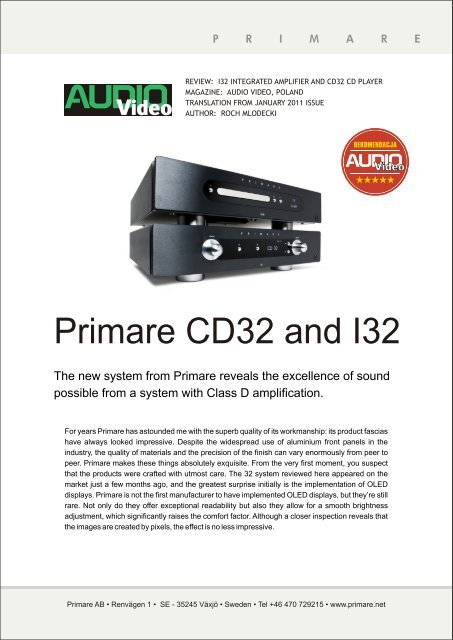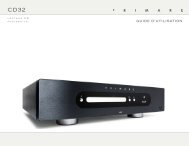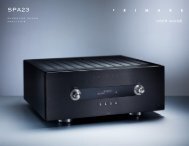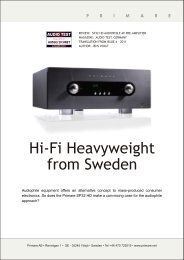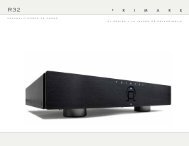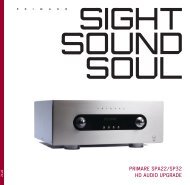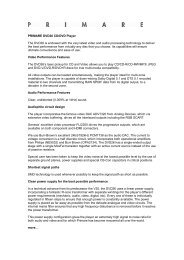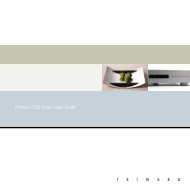I32CD32/Poland/AV/0111/eng - Primare
I32CD32/Poland/AV/0111/eng - Primare
I32CD32/Poland/AV/0111/eng - Primare
You also want an ePaper? Increase the reach of your titles
YUMPU automatically turns print PDFs into web optimized ePapers that Google loves.
P R I M A R E<br />
REVIEW: I32 INTEGRATED AMPLIFIER AND CD32 CD PLAYER<br />
MAGAZINE: AUDIO VIDEO, POLAND<br />
TRANSLATION FROM JANUARY 2011 ISSUE<br />
AUTHOR: ROCH MLODECKI<br />
REKOMENDACJA<br />
<strong>Primare</strong> CD32 and I32<br />
The new system from <strong>Primare</strong> reveals the excellence of sound<br />
possible from a system with Class D amplification.<br />
For years <strong>Primare</strong> has astounded me with the superb quality of its workmanship: its product fascias<br />
have always looked impressive. Despite the widespread use of aluminium front panels in the<br />
industry, the quality of materials and the precision of the finish can vary enormously from peer to<br />
peer. <strong>Primare</strong> makes these things absolutely exquisite. From the very first moment, you suspect<br />
that the products were crafted with utmost care. The 32 system reviewed here appeared on the<br />
market just a few months ago, and the greatest surprise initially is the implementation of OLED<br />
displays. <strong>Primare</strong> is not the first manufacturer to have implemented OLED displays, but they’re still<br />
rare. Not only do they offer exceptional readability but also they allow for a smooth brightness<br />
adjustment, which significantly raises the comfort factor. Although a closer inspection reveals that<br />
the images are created by pixels, the effect is no less impressive.<br />
<strong>Primare</strong> AB • Renvägen 1 • SE - 35245 Växjö • Sweden • Tel +46 470 729215 • www.primare.net
P R I M A R E<br />
REVIEW: I32 INTEGRATED AMPLIFIER AND CD32 CD PLAYER<br />
<strong>Primare</strong> has comprehensive inputs/outputs but still it is a pity that<br />
speaker outputs are singular.<br />
CD32 Compact Disc Player<br />
The player has only three buttons, which is slightly limiting. It is possible to power the player up,<br />
open the CD tray, play the disc, stop the disc and skip to the next or previous track. Other functions<br />
are operated via the remote control only. From the back there is access to standard RCA outputs<br />
and balanced XLRs. There are three ways to output the digital signal: Toslink, AES/EBU and<br />
S/PDIF. A USB type A input enables the connection of a USB stick or a hard disk for playing music<br />
files (MP3 or WMA). It is a bit of a nuisance that access to the port is at the back – it should be<br />
located on the front panel – but it is a good thing that the screen facilitates file title display. Other<br />
connectors, such as RS232, trigger input and output, as well as a IR will come in handy in multiroom<br />
setups or when you want all the elements of the system to switch on at the same time. Anyway,<br />
all necessary cables are included, so it’s a waste not to use them.<br />
The mechanism implemented in the CD32 is an Asatech drive. The servo circuit utilises Toshiba<br />
components. The 5-second buffer is an interesting addition as it successfully separates the<br />
mechanics from potential read errors. Power supply is based on an R-Core transformer with<br />
separate windings for the digital, analogue, and mechanical sections. In standby mode the player<br />
uses a small switch-mode power supply that lowers power consumption to a fraction of a watt (EU<br />
recommendation). In the digital-to-analogue section, the player utilises two Burr-Brown PCM1740<br />
converters combined with a DF1706 digital filter. The circuit is mounted on a few PCB modules,<br />
made possible with the implementation of surface mounting technology. This has also allowed<br />
<strong>Primare</strong> to achieve the shortest possible signal paths.<br />
<strong>Primare</strong> AB • Renvägen 1 • SE - 35245 Växjö • Sweden • Tel +46 470 729215 • www.primare.net
P R I M A R E<br />
REVIEW: I32 INTEGRATED AMPLIFIER AND CD32 CD PLAYER<br />
I32 Amplifier<br />
The main reservation I have about the operation of the I32 amplifier is the reversed mounting of<br />
control dials – the left is used for volume level control and the right for source selection. This may be<br />
a little irritating to start with but you do get accustomed to it. Then there is the power button and three<br />
buttons for browsing the menu: the first displays the menu, second confirms selection, and third<br />
allows a return to the previous screen. Browsing is facilitated by the right dial – the one used<br />
normally for source selection. What seems initially to be somewhat complicated proves in practice<br />
to be very intuitive, giving you the freedom to configure many interesting functionalities which are<br />
not available in other amplifiers. Every input can be setup to have a customised name, sensitivity<br />
level, balance setting and maximum level. The inputs which are not used can be disabled.<br />
The back panel allows for the input of a balanced signal from two sources (XLR) and the<br />
unbalanced signal from three (RCA). Two line loops make it possible to output signal to the recorder<br />
or an amplifier (pre-out). Just as in the CD player a trigger input/output for IR is available, as well as<br />
RS-232. Speaker outputs are universal and very convenient, and allow you to use cables with any<br />
type of plug, but they’ve not been doubled.<br />
That’s not all though: there is a cover above the outputs for a slot which will accept an optional<br />
upgrade board, destined to expand the I32’s capabilities considerably. Preliminary specs indicate<br />
that it will add a DAC, iPod docking station, DAB tuner, and even network audio player<br />
functionalities (Ethernet and Wi-Fi connectivity).<br />
The I32 is the first stereo amplifier from <strong>Primare</strong> to be based on its proprietary switched mode UFPD<br />
(Ultra Fast Power Device) electronics. The company maintains that the problems with Class D<br />
amplification arise from too limited a range of feedback, which causes instability through<br />
impedance variations, and rising THD with frequency. It is said that all those ills are rectified by the<br />
active use of a consistent feedback loop gain. Thanks to a PFC (Power Factor Correction) switch<br />
mode power supply, the amplifier is operationally transparent to the mains power network. Power<br />
consumption is also very low relative to the output power of the amplifier (2 x 120W per channel for 8<br />
ohms and 2 x 230W for 4 ohms), but this feature is standard in all Class D amplifiers.<br />
<strong>Primare</strong> AB • Renvägen 1 • SE - 35245 Växjö • Sweden • Tel +46 470 729215 • www.primare.net
P R I M A R E<br />
REVIEW: I32 INTEGRATED AMPLIFIER AND CD32 CD PLAYER<br />
The Sound<br />
I had formed my opinion of the amplifier’s sound when I learnt that it works in Class D.<br />
Preconceptions will often adversely influence the experience, but I tried not to rule out the possibility<br />
of a D Class amplifier ever sounding good. Although the first examples of this type have not been to<br />
my liking, the technology is improving, and it’s becoming easier to find designs that are not only<br />
energy-saving and eco-friendly, but that also satisfy our audiophile appetites.<br />
What is interesting is that this, the first Class D amplifier from <strong>Primare</strong>, also features a sound quality<br />
that is unique to this company – a sense of analytical detachment, a feeling that it is presenting the<br />
sound in the most matter-of-fact way, even at the cost of a certain cooling of emotions. In this<br />
respect the 32 system proves to be a little different from its 30 series predecessors.<br />
From the very first moment the sound is crystal clear. You sense that it is not adding to the<br />
original sound. It is therefore precise (one could even say sterile, but this would add too negative a<br />
bias). The sound is simply ‘objective’ in character, devoid of colouration. All this is done with much<br />
precision, preserving all the details so that you can hear all of them - even the smallest ones - easily.<br />
This creates a very interesting effect. You’re surprised by tiny musical resonances that were<br />
always present on the disk but now reproduced with honesty. Although at first this seems<br />
cold and impersonal, eventually it proves to be very complex and rich. What is perceived as<br />
lacking in emotion at the start becomes more <strong>eng</strong>aging with every album played. It is the<br />
micro detail that is responsible for inspiring new emotions. Vocals are not made warm but are<br />
instead very communicative. Acoustic instruments astound with the complexity of their sonic<br />
structure. Even when larger ensembles are played you will be surprised by the presence of a hidden<br />
melody line, which was once obscured by other instruments. Very precise contours define the entire<br />
audible bandwidth. Bass is agile, quick and rather deep, while high frequencies are painted with a<br />
fine resolution. To tell you the truth I did not think that sound of this character could be so<br />
musical.<br />
Our Opinion<br />
<strong>Primare</strong> 32 system is not only pleasing to the eye it also delivers a precise, clear, detailed and truly<br />
musical sound. It is worth listening to.<br />
<strong>Primare</strong> AB • Renvägen 1 • SE - 35245 Växjö • Sweden • Tel +46 470 729215 • www.primare.net
P R I M A R E<br />
REVIEW: I32 INTEGRATED AMPLIFIER AND CD32 CD PLAYER<br />
Technical data<br />
CD 32 Player<br />
Frequency Response 20Hz – 20kHz (-0.5dB)<br />
Signal to Noise Ratio 100dB<br />
THD


